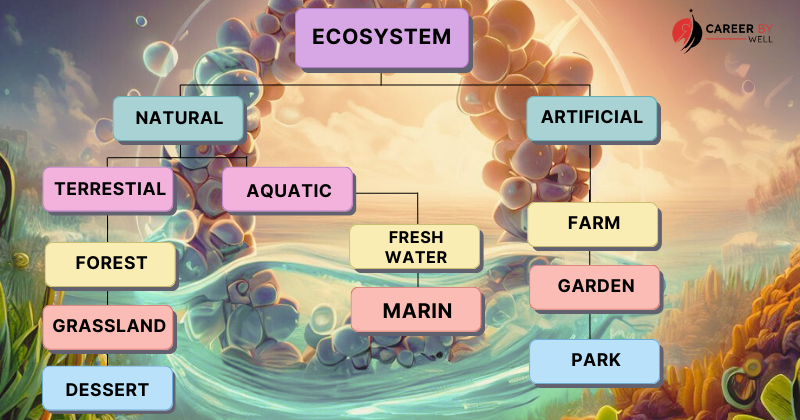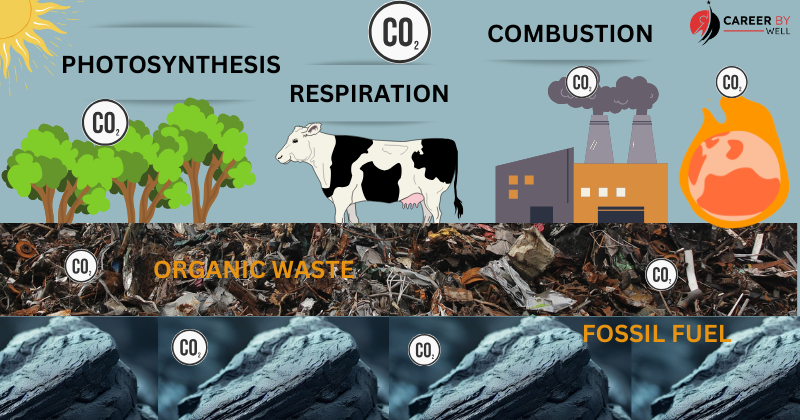There are various types of Ecosystems such as natural and artificial. Both have different characteristics and importance.
Earth’s ecosystem is very wide. There are various types of ecosystems. Each ecosystem has its place and characteristics. Let’s get to know about every type of ecosystem.
Table of Contents
What is an Ecosystem?
An ecosystem is a biological community of interacting organisms (living and non-living) and their physical environment.
It represents a distinct and functional unit in nature where living organisms, such as plants, animals, microorganisms, and their physical surroundings, interact with one another and the environment’s abiotic (non-living) components.
Types Of Ecosystems
Usually, Ecosystems are classified based on their predominant vegetation and climate, resulting in categories like terrestrial ecosystems (e.g., forests, grasslands) and aquatic ecosystems (e.g., freshwater lakes, marine ecosystems).
Understanding ecosystems and their dynamics is essential for ecological research, conservation efforts, and sustainable resource management, as they represent the intricate web of life on Earth and play a vital role in maintaining the planet’s health and balance.
Natural Ecosystem
A natural ecosystem, often referred to simply as an ecosystem, is a self-sustaining and self-regulating community of living organisms (biotic components) and their physical environment (abiotic components) in a specific geographic area.
Natural ecosystems have evolved without significant human interference and have reached a state of ecological balance over time.
Natural ecosystems can be classified as follows:
- Terrestrial Ecosystem
- Aquatic Ecosystem
Terrestrial Ecosystem
A terrestrial ecosystem is found on land and is characterized by various plants, animals, and microorganisms interacting with one another and their physical environment.
Besides, these ecosystems encompass a wide range of terrestrial habitats, each with unique ecological features and species assemblages.
However, these ecosystems are integral to the planet’s health and provide essential resources and habitats for wildlife and human populations.
Terrestrial ecosystem has three types:
- Forest ecosystem
- Dessert Ecosystem
- Grassland Ecosystem
- Tundra Ecosystem
Forest Ecosystem
A forest ecosystem is a terrestrial ecosystem characterized by a community of living organisms (biotic components) interacting with one another and their physical environment (abiotic components) within a forested area.
Forests are diverse and complex ecosystems that play critical roles in supporting biodiversity, regulating climate, and providing numerous ecosystem services.
Indeed Forests provide valuable ecosystem services, including:
- Air and Water Purification: Trees remove pollutants from the air and filter water, helping to maintain water quality.
- Carbon Sequestration: Forests store large amounts of carbon, helping to mitigate climate change by reducing atmospheric carbon dioxide levels.
- Timber and Non-Timber Products: Forests are a source of timber, wood products, and various non-timber forest products such as medicinal plants, mushrooms, and berries.
- Recreation and Tourism: Forests offer recreational opportunities for hiking, camping, and wildlife observation, contributing to tourism and local economies.
Examples of forest ecosystems include temperate deciduous forests found in North America and Europe, coniferous forests of the boreal region, tropical rainforests of South America and Southeast Asia, and temperate rainforests in the Pacific Northwest of North America.
Each forest ecosystem has unique characteristics and species adapted to its specific environmental conditions.
Forest ecosystems are globally important for their ecological, economic, and cultural significance. They contribute to the well-being of both natural ecosystems and human societies.
They make their conservation and sustainable management crucial for a healthy planet.
Dessert Ecosystem
A desert ecosystem is a unique and often harsh terrestrial ecosystem. This is characterized by arid, dry conditions, limited water availability, and extreme temperature fluctuations.
Deserts cover about one-third of the Earth’s land surface. These are known for their distinctive landscapes and specialized flora and fauna adapted to survive these challenging environments.
Examples of desert ecosystems include the Sahara Desert in Africa, the Sonoran Desert in North America, the Atacama Desert in South America, and the Arabian Desert in the Middle East.
Each desert has its unique characteristics. The flora and fauna in these ecosystems have evolved remarkable adaptations to thrive in harsh desert environments.
Grassland Ecosystem
A grassland ecosystem is a prairie, savanna, or steppe. This is a terrestrial ecosystem characterized by vast expanses of grasses, herbaceous plants, and occasional shrubs or trees.
Grasslands are found on every continent except Antarctica and are vital in supporting biodiversity. They provide habitat for various species and contribute to global carbon cycling.
Grassland ecosystems include the Great Plains of North America, the African savannas, the Eurasian steppes, and the Australian grasslands. Each type of grassland has unique characteristics based on its location and climate.
However, maintaining healthy grasslands is essential for biodiversity, carbon sequestration, and ecosystem services to wildlife and human communities.
Tundra Ecosystem
The tundra ecosystem is a unique and extreme environment found primarily in high-latitude regions near the Earth’s poles, but it can also occur at high altitudes on mountains.
It is characterized by extremely cold temperatures, low precipitation, and a short growing season.
The tundra is divided into two main types:
- The Arctic tundra in the Northern Hemisphere and
- The alpine tundra in mountainous regions worldwide.
The tundra ecosystem is a fragile and important part of our planet’s biodiversity, and understanding its unique characteristics and vulnerabilities is crucial for its long-term preservation and the survival of the species that call it home.
Aquatic Ecosystem
An aquatic ecosystem exists in a water-based environment, encompassing all living organisms (biotic components) and their physical surroundings (abiotic components) in aquatic habitats.
Further, this can be found in various environments, including freshwater and marine habitats. They are vital components of the Earth’s biosphere. This type of ecosystem is the largest ecosystem of the Earth.
Aquatic ecosystems are essential for maintaining the planet’s biodiversity and provide valuable ecosystem services, including food production, water purification, and climate regulation.
Understanding and conserving these ecosystems are critical for the well-being of both aquatic life and human societies.
These ecosystems can be classified into two groups such as:
- Fresh Water Ecosystem
- Marine Ecosystem
Fresh Water Ecosystem
A freshwater ecosystem is found in water with low salt concentrations, primarily in rivers, lakes, ponds, streams, and wetlands.
Besides, these ecosystems are critical for providing freshwater resources, supporting a wide range of aquatic and terrestrial life, and contributing to various ecosystem services.
Examples of freshwater ecosystems include the Amazon River in South America, the Great Lakes in North America, the Nile River in Africa, and the Danube River in Europe.
These ecosystems are vital for both ecological and human well-being, highlighting the importance of their conservation and sustainable management.
Marine Ecosystem
A marine ecosystem encompasses all living organisms (biotic components) and their physical surroundings (abiotic components) in marine environments, primarily consisting of saltwater bodies, including oceans, seas, and estuaries.
Indeed marine ecosystems cover approximately 71% of the Earth’s surface and are home to a vast array of species, making them the most diverse ecosystems on the planet.
Marine ecosystems are essential for regulating Earth’s climate, supporting fisheries, providing oxygen through photosynthesis, and serving as sources of inspiration and recreation for humans.
They also play a crucial role in global nutrient cycling and carbon storage. Conservation efforts aim to protect marine biodiversity, restore degraded habitats, and mitigate the impact of human activities on these vital ecosystems.
Artificial Ecosystem
An artificial ecosystem is also known as a man-made or synthetic ecosystem. Indeed, this deliberately designed and controlled environment mimics a natural ecosystem’s natural conditions and processes.
However, it is created and managed by humans. These ecosystems are typically established for various purposes, including scientific research, conservation, education, and recreational or aesthetic reasons.
Artificial ecosystems are crucial in advancing our understanding of ecology, environmental science, and conservation.
Further, they also offer opportunities for sustainable agriculture, urban greening, and controlled-environment agriculture.
Additionally, they provide unique opportunities for public engagement and education about the natural world and environmental issues.
Further, artificial ecosystems can be classified into three groups:
- Garden Ecosystem
- Parks Ecosystem
- Farms Ecosystem
Garden Ecosystem
A garden can be considered an artificial or cultivated ecosystem deliberately designed and managed by humans for various purposes, such as aesthetics, food production, recreation, or wildlife habitat enhancement.
While gardens may differ in size, complexity, and purpose, they share common features that make them distinct ecosystems.
Whether small backyard plots or expansive public landscapes, gardens play a multifaceted role in human society.
However, they offer recreation, food production, biodiversity conservation, and environmental education opportunities.
Further, gardeners can make choices that promote sustainable and ecologically friendly practices, contributing to the health of both their gardens and the broader environment.
Park Ecosystem
A park ecosystem refers to the ecological system found within a park, whether a natural, urban, or recreational area.
Indeed parks are designed and managed spaces primarily created for recreational, aesthetic, and conservation purposes, but they also serve as important habitats for various plants, animals, and microorganisms.
Overall, park ecosystems are dynamic and multifaceted environments that balance the needs of both nature and people.
Thus effective park management seeks to maintain ecological health while providing recreational and educational opportunities for the public. Parks contribute to the quality of life in urban and rural areas.
Additionally, they play an important role in fostering an appreciation for the natural world.
Farm Ecosystem
A farm ecosystem is often referred to as an agricultural ecosystem. This is a human-managed environment where various plants, animals, and microorganisms interact within a farming or agricultural setting.
Moreover, farm ecosystems are designed to produce food, fibre, and other agricultural products. These systems can vary widely in scale, practices, and types of crops or livestock involved.
Farm ecosystems are dynamic and subject to change based on evolving agricultural practices, market demands, and environmental considerations.
Further, sustainable farming approaches aim to balance the need for agricultural production with environmental stewardship and the well-being of farming communities.
Final Thoughts
In short, these are just some examples of the many types of ecosystems found on Earth.
Indeed every type of ecosystem has its own set of environmental conditions, species, and interactions that make it unique and valuable to our planet’s biodiversity and ecological balance.

